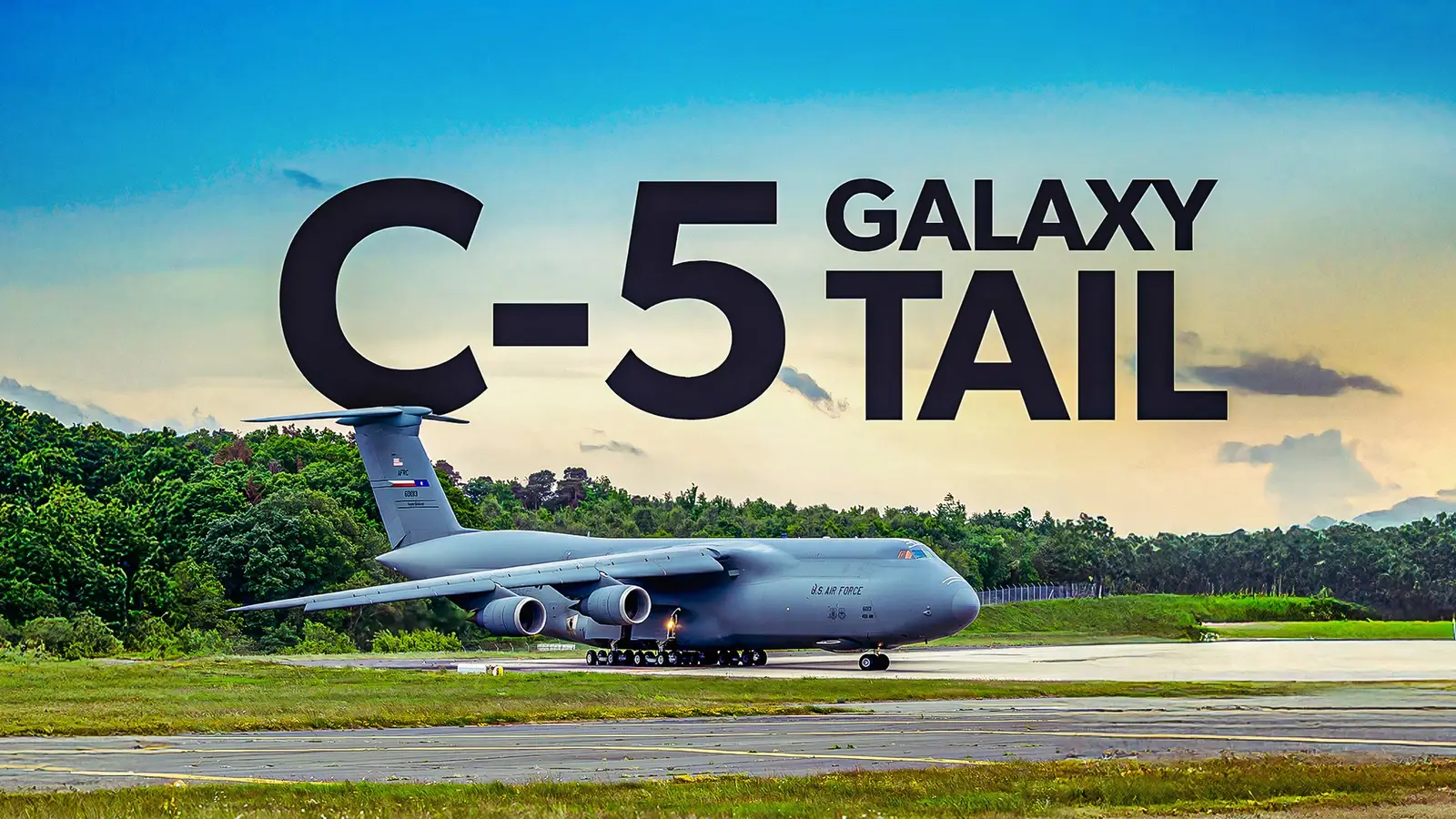
The Lockheed C-5 Galaxy was, in a way, a widebody aircraft before widebodies became prevalent. No, it doesn’t feature two passenger aisles side by side, as it was primarily intended to carry machines of war, not businessmen or families. However, this enormous aircraft was larger than almost any aircraft that came before or after it (including the Boeing 747), and it took its maiden flight before the 747 (though the 747 beat it into regular service).
As this was one of the first aircraft to be developed in this size class (and the USAF’s first plane of this size), it came with some unique design choices. One of its most distinctive design elements is its horizontal stabilizer, which is arranged as a “T-tail”. The horizontal stabilizer is located on top of the vertical stabilizer, a design that’s common in smaller aircraft, but practically unheard of in jumbo jets like the C-5. Here’s why Lockheed did this.
The Competition For The C-5 Galaxy
The contest that eventually created the C-5 Galaxy was formally initiated in 1964 as the CX-HLS (Heavy Lift System). The intent was to create a cargo aircraft more capable and far larger than the Air Force’s C-141 Starlifter, which was too small to carry most outsized equipment. After a downselect of proposals, the USAF focused on Boeing, Lockheed, and McDonnell Douglas for official submissions, while General Electric and Pratt & Whitney were chosen to compete for the engine contract.
While the three companies were each developing an aircraft to do the same thing, the three proposals had several key design differences. Lockheed, for example, went with a full upper deck, while Boeing went for a partial upper deck, and McDonnell Douglas used a pod design for the cockpit. Additionally, Lockheed’s proposal was the only one to feature a T-tail, as its competitors instead went with a conventional tail.
Lockheed’s proposal was ultimately chosen in 1965 to become the C-5 Galaxy, while General Electric was chosen to develop the revolutionary TF39 high-bypass turbofan for the aircraft. McDonnell Douglas tossed its concept into the trash bin, while elements of Boeing’s CX-HLS proposal would find themselves on the Boeing 747. Note, however, that the 747 is not the same aircraft as the CX-HLS proposal.
The Advantages Of Using A T-Tail
Most modern applications of a T-tail design in commercial aviation are on smaller planes with rear-mounted engines, which take up the space where the horizontal stabilizer would be. With the C-5, the engines are mounted under the wings. However, it’s this design choice, engines mounted on a high wing, that influenced Lockheed to design a T-tail. Moving the vertical stabilizer higher moves it further away from turbulence wakes generated by the wings and engine exhaust.
The result of this is that the plane flies more stably. As the stabilizer is not exposed to the rough air generated by the wings and engines, the stabilizer and elevator are now more effective, an effect especially prominent on the C-5 given its high-wing design. Not only that, but a T-tail design generally produces less drag than a conventional tail, boosting fuel efficiency. As such, it’s often viewed as being more aerodynamic than a conventional tail.
The McDonnell Douglas (now Boeing) C-17 Globemaster III has a similar design to the C-5, with a high-mounted wing and four engines, and it too features a T-tail. However, the two competing proposals for the CX-HLS request featured conventional tails, and Boeing’s design was generally viewed as being superior, with Lockheed winning largely on total cost. This is because just like there are benefits associated with this design, there are also major drawbacks.
Why You Might Not Want To Design A T-Tail
The most notable flaw of a T-tail design is the deep stall. This is a particularly dangerous type of stall that mainly affects T-tailed aircraft. In a normal stall, when an aircraft’s angle-of-attack (AOA) is too high, the wings lose lift. On a T-tailed aircraft, however, an extremely high AOA can cause the turbulent air in the wake of a stalled wing to affect the tailplane, significantly reducing the stabilizer’s effectiveness.
A deep stall in a T-tailed aircraft can be nearly impossible to recover from, and large transport aircraft already take significant time to recover from stalls. T-tailed planes are also more susceptible to flutter, which in turn requires additional structural stiffening to counter these effects, increasing weight. As such, using a T-tail can yield little, if any, advantage over a conventional empennage design, and this design has been disappearing from large transport aircraft design.
The Boeing and McDonnell Douglas proposals used conventional tails. Note also that the Antonov AN-124, which has a very similar design to the C-5, also uses a conventional tail. Meanwhile, all mainline commercial airliners currently in production use conventional empennages, with the Comac C909 being the most notable exception. T-tails, however, are still prevalent in general aviation and in business jets.
Why Lockheed Chose A T-Tail Design
There are pros and cons to using T-tails in modern aircraft design. Primarily, this empennage design is disappearing from large aircraft because it yields little to no benefit on a low-wing aircraft with wing-mounted engines, as nearly all airliners are configured. Planes with rear-mounted engines use a T-tail design, but this configuration is also nearly nonexistent among in-production airliners. Instead, it’s mainly private jets and GA planes that still use this design choice.
The C-5 Galaxy, however, is not an airliner, and one of its differentiating features is the high wing design. This means that the aerodynamic effects of moving the horizontal stabilizer away from the airflow generated by the wings have a greater effect. The drawbacks of a T-tail are still present, but the disadvantages of a conventional tail are more noticeable on a high-wing aircraft like the Lockheed C-5 Galaxy.
The C-5 Galaxy and C-17 Globemaster III are both high-wing planes with T-tails. However, the C-141 Starlifter that entered service before the C-5 Galaxy also featured a T-tail configuration along with engines mounted on a high wing. The Antonov AN-148 and BAe 146/Avro RJ, meanwhile, are both high-wing airliners with T-tails as well. When looking at high-wing jets with wing-mounted engines, T-tails are the norm, with the Antonov AN-124 being the notable exception.
Comparing To Other Tail Designs
As aircraft design becomes more refined, variety has declined in favor of optimized standardization. Engineers today have a far greater understanding of what saves fuel burn and how certain choices affect handling compared to five decades ago. As such, airliners today feature conventional tails and a low-wing with wing-mounted engines, even in the regional aircraft market. Private jets, being low to the ground with minimal ground clearance, feature rear-mounted engines and T-tails.
The Antonov AN-124, despite appearing visually similar to the C-5 on account of its size, design, and originally intended role, it entered service 16 years after the Galaxy. As such, Antonov enjoyed over a decade of observing the C-5’s flying characteristics and optimizing the aircraft’s design. The company clearly favored the lower weight of the conventional tail over the stability and reduced drag offered by a T-tail.
In the 1980s, the Soviet Union developed the Buran reusable spaceplane program. Components would be airlifted across the Soviet Union, and to transport the orbiter, the Soviets took the AN-124 and made significant modifications to create the Antonov AN-225. One of the major changes was to redesign the empennage, in which the horizontal stabilizer was enlarged while the vertical stabilizer was replaced by two smaller “twin tails” to avoid the wake from the top-mounted orbiter.
Rundown Of The C-5 Galaxy
Some say that large aircraft today all look the same, with only minor differences between various models. Certainly, as aerodynamics becomes better understood, plane designs have become more uniform as manufacturers continue to eek out fuel savings. However, what works for an airliner is not what is optimal for a military transport like the C-5 Galaxy. The high-wing design, coupled with four wing-mounted engines, made a T-tail more optimal for Lockheed.
The C-5 has been out of production for decades, and the aircraft was recently upgraded to the C-5M Super Galaxy, which features new avionics, upgraded equipment, flat panel displays, and new General Electric F138 engines (based on the CF6-80). Following the upgrades, the C-5 fleet is expected to remain in service until the 2040s.
If the USAF elects to directly replace the aircraft, we will be looking at an aircraft that could be designed seven decades after the C-5. As such, it’s difficult to determine what a C-5 replacement would look like. However, if it features podded engines mounted on a high wing, then that too, will likely feature a T-tail.



